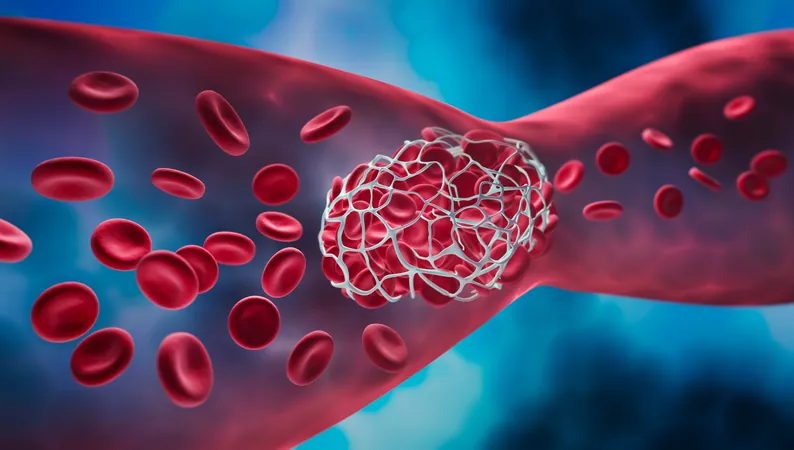
Rivaroxaban Shows Promise as an Alternative to Warfarin for Treating Left Ventricular Blood Clots Post-Heart Attack
2025-03-29
Author: Mei
Introduction
New groundbreaking research presented at the American College of Cardiology 2025 Scientific Session reveals that rivaroxaban (Xarelto; Johnson & Johnson) is just as effective as warfarin (Jantoven; Upsher-Smith) in treating patients with blood clots in the left ventricle (LV) following a serious heart attack, providing a significant advancement in cardiovascular care.
The Concern of Left Ventricular Thrombus
Left ventricular thrombus after a heart attack is a major medical concern, as it poses serious risks such as strokes and systemic embolisms. Over the years, despite the advances in anti-clotting therapies, managing LV thrombus remains complex due to a lack of robust randomized trials supporting treatment options.
The Limitations of Warfarin
While warfarin has been the go-to treatment for LV thrombus, it requires regular blood tests to ensure patients remain in a therapeutic range, making it burdensome for many. Additionally, warfarin's interactions with numerous medications and foods increase the likelihood of bleeding or ischemic complications.
Rivaroxaban: A New Hope
On the other hand, rivaroxaban, an oral factor Xa inhibitor, not only offers more predictable blood-thinning effects but also spares patients the hassle of frequent blood monitoring.
The RIVAWAR Trial
In the RIVAWAR trial, which involved 261 participants with a mean age of 55 years, researchers set out to compare the effectiveness of rivaroxaban against warfarin among post-heart attack patients with LV thrombus. The study population predominantly consisted of men, roughly 80%, with about 90% having experienced a STEMI (ST-segment elevation myocardial infarction), underscoring the high incidence of acute coronary syndrome in regions like Pakistan, where the research was conducted.
Patients in the trial were randomly assigned to receive either rivaroxaban or warfarin for a duration of three months. The primary goal was to assess the complete dissolution of the LV blood clots via echocardiograms at one and three months. Secondary objectives included monitoring total mortality, incidence of significant bleeding, and stroke rates.
Compelling Data
The data is compelling: In the rivaroxaban group, 20.1% of participants exhibited complete clot resolution after one month compared to only 8.3% in the warfarin group. By the three-month mark, both groups achieved comparable clot dissolution rates of 95.8% for rivaroxaban and 96.6% for warfarin, with no significant differences in secondary endpoints, including mortality and stroke incidents.
Expert Insights
Dr. Jehangir Ali Shah, an associate professor at the National Institute of Cardiovascular Diseases in Karachi and the principal investigator of the study, emphasized the implications of these findings: "Our results suggest that rivaroxaban could serve as a viable alternative to warfarin for managing LV thrombus in patients post-heart attack. The advantages of predictable dosing and the elimination of routine blood tests make rivaroxaban a compelling option."
Conclusion
This research not only offers hope for better management of LV thrombus but also paves the way for broader utilization of rivaroxaban in cardiovascular thrombotic conditions. As the medical community continues to seek effective treatments, the findings of this study may herald a new era in post-heart attack care, potentially transforming outcomes for countless patients.
Stay Updated
Stay updated on this evolving story as more insights emerge from the ACC 2025 Scientific Session!




 Brasil (PT)
Brasil (PT)
 Canada (EN)
Canada (EN)
 Chile (ES)
Chile (ES)
 Česko (CS)
Česko (CS)
 대한민국 (KO)
대한민국 (KO)
 España (ES)
España (ES)
 France (FR)
France (FR)
 Hong Kong (EN)
Hong Kong (EN)
 Italia (IT)
Italia (IT)
 日本 (JA)
日本 (JA)
 Magyarország (HU)
Magyarország (HU)
 Norge (NO)
Norge (NO)
 Polska (PL)
Polska (PL)
 Schweiz (DE)
Schweiz (DE)
 Singapore (EN)
Singapore (EN)
 Sverige (SV)
Sverige (SV)
 Suomi (FI)
Suomi (FI)
 Türkiye (TR)
Türkiye (TR)
 الإمارات العربية المتحدة (AR)
الإمارات العربية المتحدة (AR)